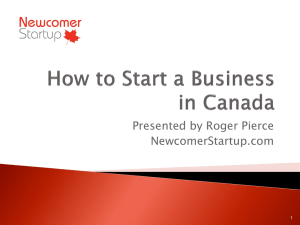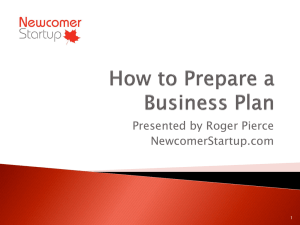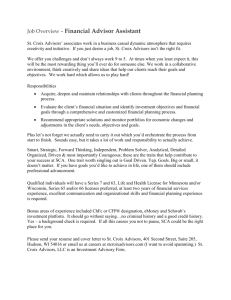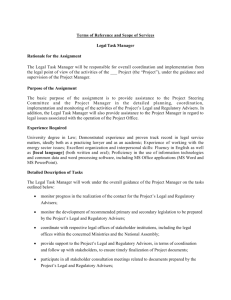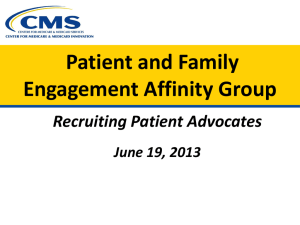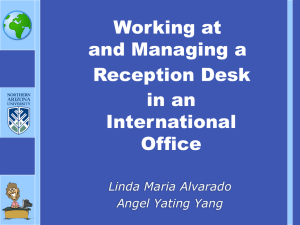KBE AEI version 9 mar 2015
advertisement
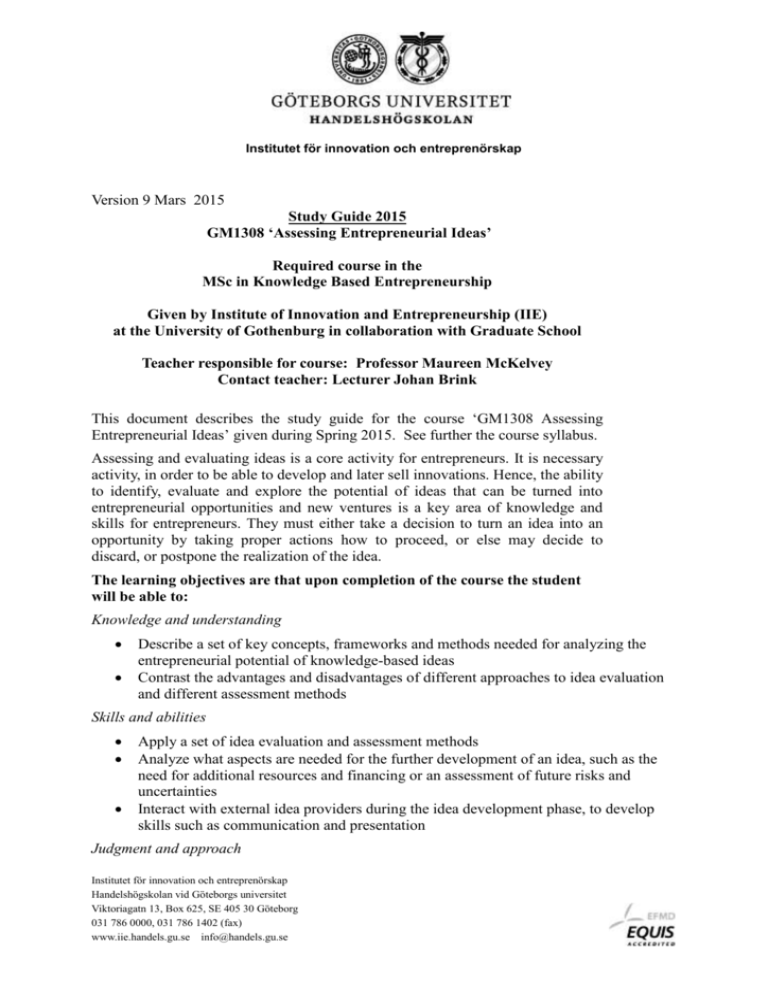
Institutet för innovation och entreprenörskap Version 9 Mars 2015 Study Guide 2015 GM1308 ‘Assessing Entrepreneurial Ideas’ Required course in the MSc in Knowledge Based Entrepreneurship Given by Institute of Innovation and Entrepreneurship (IIE) at the University of Gothenburg in collaboration with Graduate School Teacher responsible for course: Professor Maureen McKelvey Contact teacher: Lecturer Johan Brink This document describes the study guide for the course ‘GM1308 Assessing Entrepreneurial Ideas’ given during Spring 2015. See further the course syllabus. Assessing and evaluating ideas is a core activity for entrepreneurs. It is necessary activity, in order to be able to develop and later sell innovations. Hence, the ability to identify, evaluate and explore the potential of ideas that can be turned into entrepreneurial opportunities and new ventures is a key area of knowledge and skills for entrepreneurs. They must either take a decision to turn an idea into an opportunity by taking proper actions how to proceed, or else may decide to discard, or postpone the realization of the idea. The learning objectives are that upon completion of the course the student will be able to: Knowledge and understanding Describe a set of key concepts, frameworks and methods needed for analyzing the entrepreneurial potential of knowledge-based ideas Contrast the advantages and disadvantages of different approaches to idea evaluation and different assessment methods Skills and abilities Apply a set of idea evaluation and assessment methods Analyze what aspects are needed for the further development of an idea, such as the need for additional resources and financing or an assessment of future risks and uncertainties Interact with external idea providers during the idea development phase, to develop skills such as communication and presentation Judgment and approach Institutet för innovation och entreprenörskap Handelshögskolan vid Göteborgs universitet Viktoriagatn 13, Box 625, SE 405 30 Göteborg 031 786 0000, 031 786 1402 (fax) www.iie.handels.gu.se info@handels.gu.se 2 / 14 Express, justify and criticize different arguments for the feasibility and future potential of an evaluated project idea Schedule during Spring 2015: If necessary, the GUL page will be updated with any changes to the following schedule, and we send messasges to students via GUL of any changes. The course has four modules, designated M1, M2, M3 and M4 below. M1: Description of your project. This should include your evaluation of ideas, knowledge and technology in terms of resources, stakeholders and opportunities: Teacher responsible: Johan Brink M2: Patent analysis: Teacher responsible: Evangelos Bourelos M3: Market and competitor analysis. Teacher responsible: Rögnvaldur Saemundsson M4: Evaluation of ideas/projects in financial terms. Teacher responsible: Evangelos Bourelos The teachers’ roles are to develop and grade the course relative to learning objectives, to explain and introduce the content of the modules, and supervise students in conducting the analysis specified for each module in relation to their project. The role of the business advisors (business coaches) are to a) develop written background information on each project idea selected; b) facilitate the discussions and interactions between the idea providers and students, including ensuring that the idea providers work with our students; c) provide advice and feed-back to the external idea providers about the results of the students’ work and to other stakeholders in the Gothenburg innovation system; and d) optional. For those students working on their own business proposal for year 2, to provide specific time and resources to help them turn ideas into projects, and fill in the form. Readings are listed below with the schedule. Date Time /Place Readings Module / Topics Teachers or business advisors Week 13 (1) Wed 25/3 Teachers(s) and coaches 9-12, C32 Teacher: McKelvey Introduction to course - learning objectives, assessments, schedule Explain assignments and modules 3 / 14 Presentation of the groups and distribution of written material about each project Thu, 26 /3 9-12, B21 Teacher: Brink Marr, B et al, Intellectual capital – defining key performance indicators for organizational knowledge assets, Business Process Management Journal Vol. 10 No. 5, pp. 551-569, (2004) Liu Y-C. and T. Bligh, Towards an ‘ideal’ approach for concept generation, , Design Studies 24 pp. 341–355 (2003) Blair, C. and M. Mumford. Errors in Idea Evaluation: Preference for the Unoriginal? Journal of Creative Behavior, Volume 41, Number 3, Third Quarter, pp.197-222 (2007) Werner Knoll and Horton (2011) Changing the perspective: using a cognitive model to improve thinklets for ideation, Journal of management information systems, 28:1, 85-114 Kornish and Ulrich (2014) The importance of the raw Idea in Innovation, Journal of Marketing, Vol, IL, 14-16 Thu 26 / 3 13-16, GU Holding, Business advisors: Thorbjörnsson and Nilsson HT and AN schedule 1 hour meetings between each project group and the external idea provider. PLEASE CONTACT NILSSON FOR SCHEDULING A TIME Meetings with students with own ideas can be scheduled – students contact HT or AN M1 Introduction to evaluation of ideas, ideations, knowledge and technology Description of project M1 4 / 14 Fri 27/3 9-12, GU Holding Business Advisors: Thorbjörnsson and Nilsson HT and AN have scheduled 1 hour meetings between each project group and the external idea provider Meetings with students with own ideas can be scheduled on additional time – students contact HT or AN Week 14 (2) Wed 1/4 9-16, GUHolding Business Advisors: Thorbjörnsson and Nilsson Thur 2/4 9-12, Viktoriasal en Teacher: Brink Possibility for student groups to book extra meetings with the business advisors – students contact HT or AN Possibility for students with own ideas to book additional time – students contact HT or AN Levinthal, D.A. 1998. The slow pace of rapid technological change: gradualism and punctuation in technological change. Industrial and Corporate Change 7, no. 2: 217–47. Martinsuo, M.and J. Poskela, Use of Evaluation Criteria and Innovation Performance in the Front End of Innovation, J PROD INNOV MANAG ;28: pp.896–914, (2011) Ozer, M. A Survey of New Product Evaluation Models, J PROD INNOV MANAG;16: pp. 77–94,(1999) Howell J. and K. Boies, Champions of technological innovation, The Leadership Quarterly, 15, pp. 123-143 Hammedi, W. et al. Antecedents and Consequences of Reflexivity in New Product Idea M2 Evaluation of ideas, knowledge and technology, II: Evaluation models, Technology and Markets - Niche markets 5 / 14 Screening, J PROD INNOV MANAG; 28: pp.662–679 (2011) Kijkuit B. and J. van den Ende, The Organizational Life of an Idea: Integrating Social Network, Creativity and Decision-Making Perspectives, Journal of Management Studies 44:6 September pp.863-882, (2007) Christiansen J. and C. Varnes, From models to practice: decision making at portfolio meetings From models to practice. International Journal of Quality & Reliability Management Vol. 25 No. 1, pp. 87-101 (2008) Week 15 (3) Wed, 8/4 4 pm HAND-IN via GUL. 1) Ppts for presentations (15 min max) 2) 2 pages about M1 that you intend to use in the final report Friday 10/4 9-12, F44 Teacher: Brink and McKelvey Business Advisors: Nilsson and Thorbjörnsson Mandatory attendance; all presentations (Project 1-8) You are expected to attend all sessions – the matched below is which groups comment on each other Each group presents for max 15 min plus 5 min discussion. Total 20 min per group. Each group also comments on another group. This format is used for all presentations. Group 1 and 8 comment on each other. Groups 2 and 7 comment on each other. M1 Student presentation of M1 6 / 14 Groups 3 and 6 comment on each other. Groups 4 and 5 comment on each other. Week 16 (4) Tues, 14/4 13-16, C32 Teacher: Bourelos WIPO-IP for Business (http://www.wipo.int/sme) M2 Patent analysis Basberg (1987), “Patents and the Measurement of Technological Change: A Survey of the Literature,” Research Policy. 16 (2-4) pp 131-141 http://www.nber.org/chapters/c8 351.pdf Griliches, Zvi. “Patent statistics as economic indicators: a survey.” R&D and productivity: the econometric evidence. University of Chicago Press, 1998. 287-343. Tues 14/4, Wed 15/4, Thurs 16/4 GUHolding Business advisors: Thorbjörnsson and Nilsson Meet each of the 8 project groups for 30 min to 1 hour. Discussion about the project, idea provider, and situation with patents and IPR in this industry Possibility for students with own ideas to book (via doodle) in 15 to 30 min slots with business advisors on own projects Week 17 (5) Mon 20/4 9-12, C32 Teacher: Bourelos Only come to the time allocated to your group We provide supervision on your initial patent analysis, with two groups at same time 9:15-9:45 Groups 1 & 8 9:45-10:15 Groups 2 & 7 10:30-11:00 Groups 3 & 6 11:00-11:30 Groups 4 & 5 M2 Bring your draft of M2 analysis to the meeting Supervision for patent analysis 7 / 14 Tues 21/4 4 pm HAND-IN via GUL. 1) Ppts for presentations (15 min max) 2) 2 pages about M2 that you intend to use in the final report Wed 22/4 13-16, C32 Teacher: Bourelos and McKelvey Business Advisors: Nilsson and Thorbjörnsson Mandatory attendance; all presentations (Project 1-8) M2 presentation Presentation and comments for Module 2. You are expected to attend all sessions – the matched below is which groups comment on each other 13:15-13:45 Groups 1 & 7 13:45-14:15 Groups 2 & 8 14:30-15:00 Groups 3 & 5 15:00-15:30 Groups 4 & 6 Week 18 (6) Mon 27/4 9-12, C32 Teacher: Saemundsson and McKelvey Bowman, C. and V. Ambrosini (2000),Value Creation Versus Value Capture: Towards a Coherent Definition of Value Strategy British Journal of Management, Vol. 11, 1–15 Brandenburger and Stuart. (1996) Value based Business Strategy, Journal of Economics & Management Strategy VOL.5 NO 1. 5-24 Lieberman, Montgomery (1988), First Mover Advantages, Strategic Managment Journal, Vol 9 Special issue Summer 41-58. Marina Candi and Rögnvaldur J. Saemundsson, (2011) Exploring the Relationship Between Aesthetic Design as an Element of New Service Development and Performance, J PROD INNOV MANAG M3 Market and competitor analysis 8 / 14 2011;28:536–557 Recommended LEPAK, SMITH and TAYLOR, (2007) Introduction to Special Topic Value creation and Value capture, Academy of Management Review, , 32:1 180-194 Barney, Jay (1991) Firm Resources and Sustained Competitive Advantage, Journal of Management;17, 1; Tues 28/4 9-12, D31 Teacher: Saemundsson PORTER, M (2008), The Five competitive sources that shapes strategy, Barvard Business Review, JANUARY ISSUE Only come to the time allocated to your group We provide supervision on your initial market and competitor analysis, with two groups at same time 9:15-9:45 Groups 1 & 8 9:45-10:15 Groups 2 & 7 10:30-11:00 Groups 3 & 6 11:00-11:30 Groups 4 & 5 Week 19 (7) Mon 4/5 9-12, GU Holding Business advisors: Thorbjörnsson and Nilsson Meet each of the 8 project groups for 30 hour to 1 hour. Discussion about the project, idea provider, and situation with the market and competitors for this product Possibility for students with own ideas to book (via doodle) in 15 to 30 min slots with business advisors on own projects Tues 5/5 9-12, 1316, GU Business advisors: Meet each of the 8 project groups for 30 hour to 1 hour. 9 / 14 Holding Thorbjörnsson and Nilsson Discussion about the project, idea provider, and situation with the market and competitors for this product Possibility for students with own ideas to book (via doodle) in 15 to 30 min slots with business advisors on own projects Tues 5/5 4 pm HAND-IN via GUL. 1) Ppts for presentations (15 min max) 2) 2 pages about M3 that you intend to use in the final report Wed, 6/5 13-16, C32 Teachers: Bourelos and Brink Mandatory attendance; all presentations (Project 1-8) M3 Presentation Presentation and comments for Module 2. You are expected to attend all sessions – the matched below is which groups comment on each other 13:15-13:45 Groups 1 & 7 13:45-14:15 Groups 2 & 8 14:30-15:00 Groups 3 & 5 15:00-15:30 Groups 4 & 6 Week 20 (8) Mon 11/5 9-12, C32 Teacher: Bourelos Tues 12/5 13-16, C32 Teacher: Bourelos Metrick, A and Yasuda, A. Venture Capital and the Finance of Innovation, Weily, 2011 M4 Venture / project valuation Metrick, A and Yasuda, A. Venture Capital and the Finance of Innovation, Weily, 2011 M4 Intro M4 practical assessment, including examples of old cases Venture / project valuation Lecture and handson questions 10 / 14 Week 21 (9) Monday 18/5 Only for students with ‘own ideas’ for year 2 project Noon via GUL Deadline to hand-in document / proposal Mon 18/5, 9-12, Tues 19/5, 9-12, Wed 20/5 13-16 GUHolding Business advisors: Thorbjörnsson and Nilsson Meet each of the 8 project groups for 30 hour to 1 hour. Discussion about the project, idea provider, and financing possibilities that could be pursued. Possibility for students with own ideas to book (via doodle) in 15 to 30 min slots with business advisors on own projects Tues 19/5 13-16, C32 Bourelos Only come to the time allocated to your group We provide supervision on your initial market and competitor analysis, with two groups at same time 13:15-13:45 Groups 1 & 8 13:45-14:15 Groups 2 & 7 14:30-15:00 Groups 3 & 6 15:00-15:30 Groups 4 & 5 Thurs, 21/5 9-12, Viktoriasal en Teachers: Bourelos and McKelvey Business advisors: Thorbjörnsson and Nilsson Mandatory attendance; all presentations (Project 1-8) M4 Presentations Presentation and comments on each other for Module 4. You are expected to attend all sessions – the matched below is which groups comment on each other 9:15-9:45 Groups 1 & 6 9:45-10:15 Groups 2 & 5 10:30-11:00 Groups 3 & 8 11:00-11:30 Groups 4 & 7 Week 22 (10) Mon, 25/5 All project groups Deadline to hand in short summary of your AEI project, 11 / 14 using the same form circulated for own project ideas Tue 26/5 HANDELS MEETINGPOINT: Knowledge Intensive Entrepreneurship: What can we learn from tech and creative industries? 8.30-Lunch Students must register via the email registration, which will be sent in April. You are expected to take an active role, which Maureen will explain to you. Thurs 28/5 noon All project groups Deadline for hand-in of your final report, including M1-M4 Fri 29/5 noon All individuals Deadline for Hand-in of individuals preferences of projects and teams for MPE Y2 Week 23 (11) Tues, 2/6 9-12, D31 Teachers: Mandatory attendance McKelvey, Brink, Bourelos, Meeting for the formation of teams and projects for year 2 Business advisors: Nilsson, Thorbjörnsson Fri, 5/6 16.3021.30 Viktoriagatan 30 Exam 8.00-13.00 Folkets Hus Re-Exam Week 34 17/8 Contact information Institute for Innovation and Entrepreneurship (IIE) Department of Economy and Society Teachers: Maureen McKelvey, Professor at IIE 12 / 14 Johan Brink, Senior Lecturer at IIE, contact teacher for this course Evangelos Bourelos, Lecturer / researcher at IIE Rögnvaldur Saemundsson Lecturer / researcher at IIE http://es.handels.gu.se/english/units/institute-for-innovation-and-entrepreneurship Business Advisors: Anders Nilsson, Senior Business Advisor, IIE Håkan Thorbjörnsson, GU Holding, IIE GS Administrator Ellen Morris, Administrative Coordinator, Graduate School Project and team based evaluation The team-based evaluation is 45% of the grade. Students present four times during the course (see schedule), and all presentations are mandatory. You must also hand-in a preliminary draft of your findings for each module, when you present. These are not graded, but they enable us to give you feed-back for writing the final report. You should use and improve these, to turn the drafts into the final report. The final hand in is graded and includes one report per team. Each report should be in the range 10 to max 15 pages per report, 1,5 spacing, times new roman. The report includes 1 page executive summary as well as at least 2 pages per module. Your work consists of assessing entrepreneurial ideas provided by external idea providers. Each team should during the course assess and develop one original idea, and this project is run in collaboration with our partner, GU Holding. In order to understand and also further develop these original ideas each team will have to be in interaction with the original idea providers during the course. Note that you may need more time and meeting than those defined as 'group work' on the schedule, but the business advisors role is to facilitate these meetings. Each report will consist of the following course modules: M1: Description of your project. This includes evaluation of ideas, knowledge and technology, in terms of stakeholders and opportunities. o First: Provide a short description of the main idea; this also includes an analysis of key resources and stakeholders. Clarify the original application/opportunity identified. The idea provider can often provide this in a rough state but you need to put this into your own words. o Second: One idea doesn’t necessary correspond to just one single application/opportunity but instead can be developed and open up the door to several applications/opportunities. This might involve taking and developing the raw idea into different appplications/products/businesses. You should, for the idea given in your project, development of two different potential opportunities. Thus you should besides the initial given idea generate and develop a second potential area of applications/opportunity where the main original idea (and its resources identified earlier) also could be applied. As an example this involve using something originating from the initial idea (such as 13 / 14 resources or technology) for very different needs and markets. o Third: Relate the various evaluation techniques and processes, including their difficulties to the final evaluation of your own project. You should, at the projects end, besides the financial evaluation in M4 (below), also be able to motivate your final recommendations and relate back to these various techniques and their inherent strength and weaknesses. M2: Patent analysis In this module, you should understand and use the concepts of analysis of patents and related intellectual assets and apply these to your project. In other words, use the lectures, concepts and theories from M2 to provide an overview that describes the current situation for your project (relative to the competitive situation in terms of patents and intellectual asses), in developing your specific patent analysis. You must work hands-on with this analysis. More specifically describe and discuss: if the idea is patentable or not, if there is any freedom to operate (risks of infringements and relationship to prior art), if it make sense for the business to patent or not. M3: Market and competitor analysis. In this module, you should be understand and use the concepts of analysis of market and competitors and apply these to your project. In other words, use the lectures, concepts and theories from M3 to provide an overview that describes the current situation for your project, in developing your specific analysis of the market and competitors. You must work hands-on with this analysis. More specifically Given what you see as an business opportunity in this idea will the idea provide a competitive advantage and provide any financial returns? M4: Evaluation of ideas/projects in financial terms Specify one of the ideas (business model) that this project could be used and evaluate the financial potential for further business development. You will have to evaluate the two applications for a good and a bad scenario. At first, you will use the traditional assessing methods and calculate the NPV (such as based on expected cash flow, income, expenses and their uncertainty/risk). Second, you will assess the ideas by using more advanced techniques of real option valuation. At the end, you will have to compare the different methods and justify your assessments. Explain your choice of how to evaluate it, financially. Motivate and present your choice, especially in terms of stating your decision-criteria for the go/no-go decision (Do also relate to issues brought up during M1!). Presentations and hand-ins. For each module, as defined above, each group must hand in their presentation and a 2 page draft of that section. This draft will be used to constitute the final report, due at the end of the course. For each module presentation, the group will present for max 15 min plus 5 min discussion. Total 20 min per group. Each group also comments on another group. This format is used for all presentations. The final hand-in consists of the final report, including all four modules. The students should also hand-in the short form describing the business models, e.g. the same form used for student own ideas. The business advisors are expected to use this material to help develop businesses at the external idea providers. Individual written exam: 14 / 14 The individual written exam can cover any and all aspects of the course, including lectures, readings, reflections about the project work, details of modules, etc. The individual written exam is a 55% of the grade. The student must sign up for exam and reexams, and these are scheduled via Graduate School. Reading list of books. Note that articles are listed above in the table Metrick, A and Yasuda, A. Venture Capital and the Finance of Innovation, Weily, 2011
